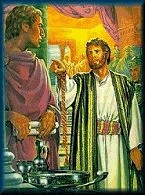 |
 |
|
In what manner did Jehovah "call to account against the king
of Babylon and . . . against the land of the Chaldeans . . . their error" mentioned at
Jeremiah 25:12? As explained in the previous article, Cyrus the Great proclaimed himself "king of Babylon" and at first did not alter the policy of the Babylonian dynasty of King Nebuchadnezzar of keeping the captives. Thus the nations subjugated by Nebuchadnezzar continued to serve "the king of Babylon" seventy years. Only in the seventieth year of the desolation of Judah did Cyrus the Great release the exiled Jews from their direct servitude to the king of Babylon and let them return home to rebuild their desolated country and their national capital Jerusalem and its temple. (Ezra 1:1 through 3:2) In this way Jehovah called to the account of the Babylonians "their error" that they had committed against the God of Israel.—Jeremiah 25:12. But does this mean that Jehovah held Babylon to account for executing his judgment against his people? Knowing
what "their error" was will make it clear that that is not the case. The indications are that Nebuchadnezzar
was extremely religious, building and beautifying the temples of numerous Babylonian deities. Particularly was
he devoted to the worship of Marduk (or Merodach), the chief god of Babylon and likely a deified Nimrod. To him
Nebuchadnezzar gave credit for his military victories. Trophies of war, including the sacred vessels of Jehovah's
temple, appear to have been deposited in the temple of Marduk. (Ezra 1:7; 5:14) Says an inscription of Nebuchadnezzar:
"For thy glory, O exalted MERODACH a house have I made. . . . May it receive within itself
the abundant tribute of the Kings of nations and of all peoples!"—Records of the Past: Assyrian and Egyptian
Monuments, London, 1875, Vol. V, p. 135. And it was these trophies of war from Jehovah's temple that were used
by Belshazzar during his drunken party on the night of the Medo-Persian invasion.—Daniel 5:2-4. Jehovah therefore declared:
Thus, as declared in Jeremiah 25:12, Jehovah's judicial decision was to "make it desolate wastes to time indefinite" after the conclusion of the seventy years. When though, did this actually occur? As can be seen, Cyrus did not desolate Babylon when he conquered it. No, Babylon still existed for some time, but from 539 B.C.E. its glory began to fade as the city declined. While some critics try to prove that this verse applies to 539 B.C.E. only, the facts prove otherwise. Consider the following, in chronological order:
Therefore, notwithstanding some recent, discontinued efforts at rebuilding parts of it, the desolate condition of Babylon today testifies to the fulfillment of Jeremiah 25:12. This verse could be read and understood the most naturally as:
If it was fulfilled in 539 B.C.E., notice what happens:
Since the fall of Babylon and the end of the Babylonian exile are not synchronized as the later ended in Cyrus' first regnal year, 539 B.C.E. does not fit, especially since Babylon was used as a capital city. Interestingly, in the secular chronology based on Ptolemy's canon, Nebuchadnezzar's first regnal year was 605 B.C.E., which is four years after the supposed starting year 609 B.C.E.! These glaring discrepancies forces 539 B.C.E. out of Jeremiah 25:12, as only 537 B.C.E. can be referred to. (See appendix article: The Babylonian Exile of the Jews – The Bible Versus the Traditional Chronology by Rolf Furuli.) Indeed, Jeremiah 25:12 most emphatically applies to the fulfillment of desolation against Babylon after
her fall in 539 B.C.E. and not on her fall.
Babylon today. The structures around the ruins reflect the Saddam Hussein administration's discontinued plans of rebuilding parts of it. The building on the hill to the left is a modern presidential palace.
|
| Home
| Contents Last revised: February 4, 2008. Copyright © 1997 by Jehovah's Witnesses—Setting the Record Straight. All rights reserved. This web site is not affiliated with or sanctioned by the Watchtower Bible and Tract Society. However, every effort has been made to adhere to the current views published by the "faithful and discreet slave" (Matthew 24:45; Luke 12:42) through the Watchtower Bible and Tract Society. The "Official Web Site of Jehovah's Witnesses" can be found at http://www.jw.org, and should be recognized as the authoritative source about the beliefs, teachings, and activities of Jehovah's Witnesses. |